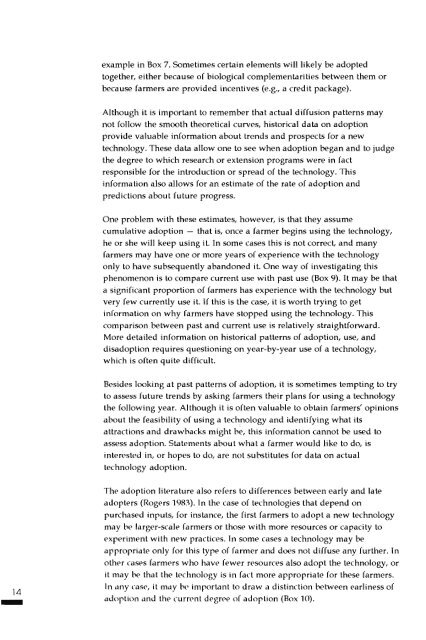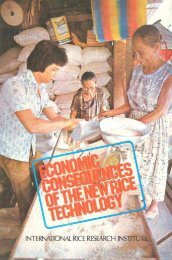The Adoption of Agricultural Technology - Food Security Group
The Adoption of Agricultural Technology - Food Security Group
The Adoption of Agricultural Technology - Food Security Group
You also want an ePaper? Increase the reach of your titles
YUMPU automatically turns print PDFs into web optimized ePapers that Google loves.
example in Box 7. Sometimes certain elements wi1llikely be adoptedtogether, either because <strong>of</strong> biological complementarities between them orbecause farmers are provided incentives (e.g., a credit package).Although it is important to remember that actual diffusion patterns maynot follow the smooth theoretical curves, historical data on adoptionprovide valuable information about trends and prospects for a newtechnology. <strong>The</strong>se data allow one to see when adoption began and to judgethe degree to which research or extension programs were in factresponsible for the introduction or spread <strong>of</strong> the technology. Thisinformation also allows for an estimate <strong>of</strong> the rate <strong>of</strong> adoption andpredictions about future progress.One problem with these estimates, however, is that they assumecumulative adoption - that is, once a farmer begins using the technology,he or she will keep using it. In some cases this is not correct, and manyfarmers may have one or more years <strong>of</strong> experience with the technologyonly to have subsequently abandoned it. One way <strong>of</strong> investigating thisphenomenon is to compare current use with past use (Box 9). It may be thata significant proportion <strong>of</strong> farmers has experience with the technology butvery few currently use it. If this is the case, it is worth trying to getinformation on why farmers have stopped using the technology. Thiscomparison between past and current use is relatively straightforward.More detailed information on historical patterns <strong>of</strong> adoption, use, anddisadoption requires questioning on year-by-year use <strong>of</strong> a technology,which is <strong>of</strong>ten quite difficult.Besides looking at past patterns <strong>of</strong> adoption, it is sometimes tempting to tryto assess future trends by asking farmers their plans for using a technologythe following year. Although it is <strong>of</strong>ten valuable to obtain farmers' opinionsabout the feasibility <strong>of</strong> using a technology and identifying what itsattractions and drawbacks might be, this information cannot be used toassess adoption. Statements about what a farmer would like to do, isinterested in, or hopes to do, are not substitutes for data on actualtechnology adoption.-14<strong>The</strong> adoption literature also refers to differences between early and lateadopters (Rogers 191B). In the case <strong>of</strong> technologies that depend onpurchased inputs, for instance, the first farmers to adopt a new technologymay be larger-scale farmers or those with more resources or capacity toexperiment with new practices. In some cases a technology may beappropriate only for this type <strong>of</strong> farmer and does not diffuse any further. Inother cases farmers who have fewer rc>sources also adopt the technology, orit may he that the technology is in fact more appropriate for these farmers.In any casc>, it may bl' important to draw a distinction between earliness <strong>of</strong>adoption and the currc>nt degrc>e <strong>of</strong> adoption (Box 10).



